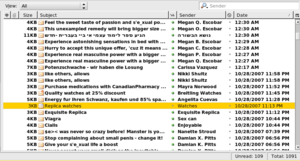I’ll admit it: I have an e-mail problem.
At this moment, there are 1,944 unanswered messages in the Inbox of my private account, and 2,730 in the Inbox of my public account. And that’s after taking a deep breath and deleting all the unanswered ones from 2008 and 2009, which I realized would be too embarrassing to answer anyway.
I’m a special case, of course. My e-mail address is published everywhere, and I write about a subject that’s among the most baffling in the world — technology. Many people write me in hopes of getting “what should I buy” advice, seeking “how do I fix it” information or just responding to something they’ve read.
Still, I’m not the only one with an e-mail problem. Among my friends, many have hundreds or thousands of messages sitting unanswered at this moment. It’s a broken system, for sure.
Yesterday, someone posted a Web site called emailcharter.org. It’s 10 principles that are designed to ease the problem.
This isn’t a new idea; you can find similar articles all over the Internet. (You can also find “zero-inbox” advocates online: people who advocate filing all e-mail every day, so you always leave work with an empty Inbox. To me, though, that’s just a self-fakeout. You’re just shuffling the same unanswered messages into folders.)
What is new, though, is that the “someone,” in this case, is Chris Anderson, who runs the high-profile TED conferences. Both the speakers and the audiences for this conference are exactly the kind of well-known influencers — with bulging In boxes — that might help him start a movement.
The Charter site goes like this: “E-mail overload is something we are inadvertently doing to each other. You can’t solve this problem acting alone. You will end up simply ignoring, delaying, or rushing responses to many incoming messages, and risk annoying people or missing something great. That prospect is stressful.”
Instead, Mr. Anderson sets out 10 principles that he hopes the world will adopt. They range from the general (“Respect recipients’ time”) to the very specific (“If your e-mail message can be expressed in half a dozen words, just put it in the subject line, followed by EOM (= End of Message). This saves the recipient having to actually open the message”).
Related articles
- TED’s Chris Anderson Is The Moses Of Email Overflow (fastcompany.com)
- The Great Email Schism: From Gmail’s New Doodads To Chris Anderson’s Messaging Manifesto (fastcompany.com)
- Help Create an Email Charter! (tedchris.posterous.com)
- Shortmail: “Twitter For Email” Has 500 Character Limit, Forces Conciseness (fastcompany.com)









